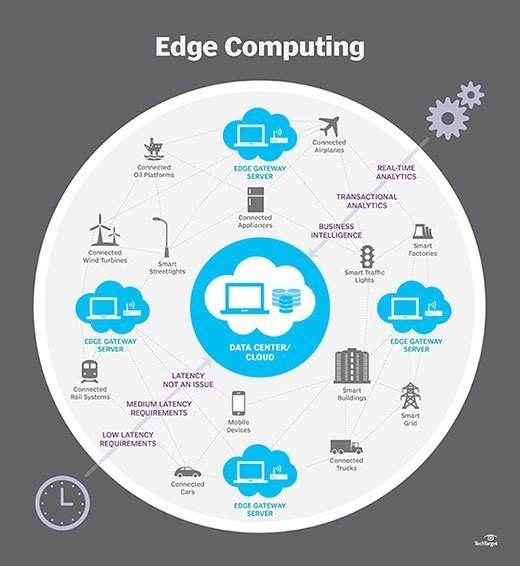5 edge computing basics you need to know
Edge computing is forcing IT teams to rethink legacy architectures. In this guide, explore edge computing basics, including its pros and cons and its effect on enterprise networks.
In an era of immense technological transformation, the networking industry is on the edge of its seat for promising technologies and network architectures -- like edge computing.
The term may sound familiar, but how does one define edge computing? This network architecture brings data processing closer to applications and other data sources -- with "closer" being at the network's edge. While edge computing isn't new, the increasing number of IoT devices in networks has brought a heightened focus to the edge, launching the architecture to its current popularity. Edge computing benefits include reduced costs and faster response times, yet the architecture can introduce challenges to networks, as well.
This compilation of edge computing basics defines edge computing and explores how it differs from the network edge and cloud computing. It also answers common questions about the effect of edge computing on networks and IT teams.
What is edge computing and how is it different from the network edge?
Edge computing architecture is a modernized version of data center and cloud architectures with the enhanced efficiency of having applications and data closer to sources, according to Andrew Froehlich, president of West Gate Networks. Edge computing also seeks to eliminate bandwidth and throughput issues caused by the distance between users and applications.
Edge computing is not the same as the network edge, which is more similar to a town line. A network edge is one or more boundaries within a network to divide the enterprise-owned and third-party-operated parts of the network, Froehlich said. This distinction enables IT teams to designate control of network equipment.
Read more about the network edge vs.edge computing basics.
How will edge computing affect enterprise networks?
Edge computing's ability to bring compute and storage data in or near enterprise branches is attractive to those who require quick response times and support for large data amounts. Edge computing can bring several benefits to enterprise networks with centralized management, lights-out operations and cloud-style infrastructure, according to John Burke, CIO and principal research analyst at Nemertes Research Group, based in Mokena, Ill.
Centralized management enables edge computing to keep networks orderly and evenly maintained. This management enables lights-out -- or remotely managed -- operations, so on-site staff rarely has to deal with these transactions, Burke said. The cloud-style infrastructure can help IT teams deliver local services and manage local resources accordingly.
Learn more about edge computing benefits for enterprise networks.

How can edge computing and IoT reshape networks?
The growth of IoT is a major factor in edge computing's popularity, and these innovations are forcing enterprises to reconsider best practices for processing IoT device data. Together, edge computing and IoT can benefit networks, as they can reduce WAN transport costs and prevent quality of service issues, said Kevin Tolly, founder of the Tolly Group. The two also enable immediate processing and analysis of data.
Yet traditional networks weren't built to support this type of architecture, so IT teams may require new -- or at least supplemental -- networking gear for the transition, Tolly said. Gear including Wi-Fi 6 access points, multi-gigabit capabilities and hyper-converged infrastructure are among trends that could benefit edge computing and IoT for enterprise networks.
Discover more IoT and edge computing basics for network trends.
What edge computing challenges do enterprise networks face?
No compilation of edge computing basics is complete without edge computing benefits and challenges. Despite its benefits, edge computing can create complications that could leave centralized IT teams on edge. Six of these challenge areas are network bandwidth, distributed computing, latency, security, data backup and data accumulation, according to independent analyst John Fruehe.
A common thread between these issues is traffic. Data traffic doesn't always follow a singular path, due to distributed applications and devices, and edge computing opens up another path in order to process data closer to its sources, Freuhe said. Disorganized traffic can lead to difficulties in developing security and compute models, and IT teams may need to reconfigure their networks to support basic edge computing capabilities.
Dive further into these edge computing challenges.
How does edge computing affect cloud environments and networks?
No universal, or one-size-fits-all, basic edge computing architecture currently exists, so IT teams shouldn't assume any architecture will work for their specific network. Including edge computing basics in future network planning can strongly affect the network's relationship to cloud computing as well, said David Jacobs of The Jacobs Group. Edge computing could act as an alternative to or a complement of cloud computing for fewer data processing delays.
As data traverses the network in its journey to cloud environments, it can cause delays -- and edge computing can eliminate them. While both edge computing security and cloud security have challenges, storing data at the edge would mean less vulnerable information is available at individual sites. This saves IT teams from shutting entire networks down if they become compromised, Jacobs said.
Explore more about the future of edge computing and networks.







